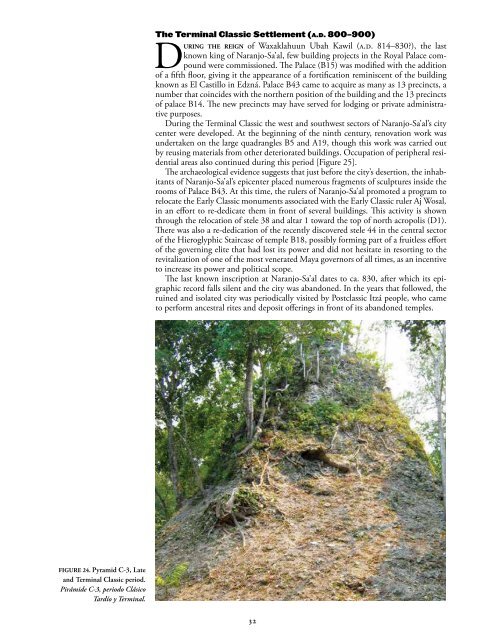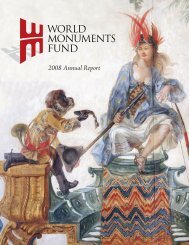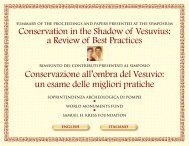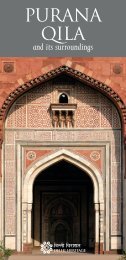NaraNjo-Sa'al - World Monuments Fund
NaraNjo-Sa'al - World Monuments Fund
NaraNjo-Sa'al - World Monuments Fund
You also want an ePaper? Increase the reach of your titles
YUMPU automatically turns print PDFs into web optimized ePapers that Google loves.
Figure 24. Pyramid C-3, Late<br />
and Terminal Classic period.<br />
Pirámide C-3, periodo Clásico<br />
Tardío y Terminal.<br />
The Terminal Classic Settlement (a.d. 800–900)<br />
During the reign of Waxaklahuun Ubah Kawil (a.d. 814–830?), the last<br />
known king of Naranjo-Sa’al, few building projects in the Royal Palace compound<br />
were commissioned. The Palace (B15) was modified with the addition<br />
of a fifth floor, giving it the appearance of a fortification reminiscent of the building<br />
known as El Castillo in Edzná. Palace B43 came to acquire as many as 13 precincts, a<br />
number that coincides with the northern position of the building and the 13 precincts<br />
of palace B14. The new precincts may have served for lodging or private administrative<br />
purposes.<br />
During the Terminal Classic the west and southwest sectors of Naranjo-Sa’al’s city<br />
center were developed. At the beginning of the ninth century, renovation work was<br />
undertaken on the large quadrangles B5 and A19, though this work was carried out<br />
by reusing materials from other deteriorated buildings. Occupation of peripheral residential<br />
areas also continued during this period [Figure 25].<br />
The archaeological evidence suggests that just before the city’s desertion, the inhabitants<br />
of Naranjo-Sa’al’s epicenter placed numerous fragments of sculptures inside the<br />
rooms of Palace B43. At this time, the rulers of Naranjo-Sa’al promoted a program to<br />
relocate the Early Classic monuments associated with the Early Classic ruler Aj Wosal,<br />
in an effort to re-dedicate them in front of several buildings. This activity is shown<br />
through the relocation of stele 38 and altar 1 toward the top of north acropolis (D1).<br />
There was also a re-dedication of the recently discovered stele 44 in the central sector<br />
of the Hieroglyphic Staircase of temple B18, possibly forming part of a fruitless effort<br />
of the governing elite that had lost its power and did not hesitate in resorting to the<br />
revitalization of one of the most venerated Maya governors of all times, as an incentive<br />
to increase its power and political scope.<br />
The last known inscription at Naranjo-Sa’al dates to ca. 830, after which its epigraphic<br />
record falls silent and the city was abandoned. In the years that followed, the<br />
ruined and isolated city was periodically visited by Postclassic Itzá people, who came<br />
to perform ancestral rites and deposit offerings in front of its abandoned temples.<br />
32
















